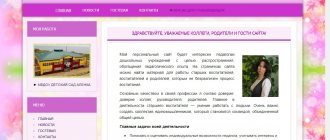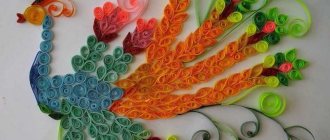MAGAZINE Preschooler.RF
Interactive board as a means of developing coherent speech in children of middle preschool age.Performed by the teacher of the middle group, Timergazina Irina Infasovna.
Our children show little interest in fiction; their dialogical speech is not particularly expressive and is limited to simple monosyllabic sentences. Having a poor vocabulary, they find it difficult to formulate an answer to a question, compose a story or description based on a plot picture, which reduces the level of motivation. In such conditions, modern information technologies come to the rescue as one of the sources of motivation for the development of coherent speech in preschoolers.
There are various information tools that can be successfully used in the development of coherent speech in children. One of these unique tools is the interactive whiteboard. An interactive board (ID) is a universal tool that allows you to make lessons with preschool children more interesting, visual and fun.
Compared to traditional forms of teaching preschoolers, information and communication technologies have a number of advantages: presenting information on the screen - carries a figurative type of information that is understandable to preschoolers; movements, sound, animation attract the child’s attention for a long time; enhances the supply of material; helps the teacher to be in constant interaction with children; electronic learning tools transmit information faster than traditional ones; develops motivation and makes activities more interesting for children; children begin to understand more complex points as a result of a clearer and more dynamic presentation of the material; provides the opportunity to individualize training; gains confidence in himself that he can do a lot.
Methods of using an interactive whiteboard as a means of developing coherent speech in children can be limited only by the imagination of the teacher. These include mnemonic tables, mnemonics and various interactive educational programs, didactic games for speech development, mind maps, thematic disks for working with an interactive whiteboard as part of the implementation of a software and methodological complex. The easiest way for a teacher to use an interactive whiteboard is to demonstrate ready-made presentations. The interactive whiteboard simplifies the preparation of lessons, the search for illustrations, educational pictures and cards, and the use of various equipment. Story pictures help in the formation of coherent speech. You can attach sound tabs to these pictures, sounds of nature, children's songs, as well as videos (for example, snow falling, leaves falling, a storm at sea).
The use of ICT allows us to move from an explanatory and illustrated method of teaching to an activity-based one, in which the child becomes an active subject, and not a passive object of pedagogical influence. This contributes to the conscious assimilation of knowledge by preschoolers, their mental and speech development. After studying the mnemonic track based on the fairy tale, children can independently depict and tell it on the interactive board. Connected speech is the most complex form of speech activity. It has the character of a consistent, systematized, detailed presentation. The main function of coherent speech is communicative. The development of both forms of speech - monologue and dialogue - plays a leading role in the process of developing a child’s speech and occupies a central place in the overall system of work on speech development in kindergarten. Children enjoy reading poems using mnemonic tables, guessing riddles, and selecting the details of the mnemonic table on the interactive board to create a story.
Mnemonics make it easier for children to master coherent speech. The child, relying on memory images, establishes cause-and-effect relationships and draws conclusions, thereby developing logical thinking. The use of mnemonics and the use of generalizations allow the child to systematize his direct experience. With the help of mnemonic tables, children tell fairy tales and compose stories.
When creating classes using ID, it is necessary to take into account the existing knowledge acquired in traditional classes during the implementation of the main educational program. ID should be a didactic tool, not an end in itself.
A mind map is a unique and simple method of memorizing information, with the help of which both the creative and speech abilities of children develop and thinking is activated. Mind maps came to the world of preschool technologies thanks to the candidate of pedagogical sciences V.M. Akimenko, who proposed using this method for the development of coherent speech in children. By completing this task, children learn to independently and consistently express their thoughts, become more active when speaking, develop the ability to answer questions in a general manner, and their vocabulary becomes accurate and varied.
An interactive game is both entertaining and useful material during classes. Children enjoy completing interactive tasks and exercises that promote the development of coherent speech.
Modern computer technologies allow us to combine and systematize existing material on the development of coherent speech, avoid wasting time searching for manuals on the shelves of the office, copying illustrations, and storing a large amount of speech material. This material can be stored on disks, flash cards and in the computer itself. The computer allows us not only to show and see, but also to hear the necessary speech material. In this case, we can use the computer as a CD player.
The use of information technology in the classroom at a preschool educational institution makes it possible to overcome the intellectual passivity of children in the classroom and makes it possible to increase the effectiveness of the educational activities of the preschool educational institution teacher. By using an interactive whiteboard as a means of developing coherent speech, children’s knowledge about the world around them increases; there is a desire to retell texts and come up with interesting stories; there is an interest in learning poems and nursery rhymes; vocabulary reaches a higher level; children overcome timidity and shyness, learn to behave freely in front of an audience.
| Next > |
Master class “Interactive games in working with young children.”
Dear colleagues, I bring to your attention a master class “Interactive games in working with young children.”
The possibilities of using information and communication technologies make it possible to most fully and successfully implement the development of a child’s abilities, increase the efficiency of the educational process, make it diverse, lively and unobtrusive for children.
I consider the most appropriate and effective for practical developmental work with early preschool children to be the use of an interactive whiteboard as a means of teaching and developing children.
An interactive didactic game is a modern and recognized method of teaching and upbringing, which has educational, developmental and nurturing functions that operate in organic unity.
I have developed interactive games that I use as part of classes in the second half of the school year, both in the formation of elementary mathematical concepts, and in familiarization with the environment, in drawing.
Game " In the garden, in the vegetable garden ."
Purpose of the game: to consolidate children's knowledge about vegetables and fruits. Learn to divide them into 2 groups.
- Children, look, what pictures do you see on the screen? What is this? (Basket). What color is the basket? (Red). And what's that? (Basket). What color is this basket? (Yellow). What pictures do you see below? (Tomato, apple, cucumber, etc.). Apple, pear - what is it? (Fruits). And tomato, cucumber, cabbage, how can you call it in one word? (Vegetables).
We need to put all the vegetables in the red basket, and all the fruits in the yellow basket. (I call each child in turn).
Game: “ Who lives where?”
Target. Strengthen children's knowledge about domestic and wild animals.
— Children, name the animals you see on the screen. Ira, who is this? Roma, who is this? What's that on the board? (House, forest). Guys, the animals got lost and can’t find their houses. Let's help them and take them home. Sasha, who is this? (Cat). Where she lives? (In the house). Help her get to the house. Karina, who is this? (Bear). Where does the bear live? (In the forest). Take the bear to the forest. Well done! Etc.
Game "One - Many".
Goal: to consolidate children’s knowledge about the number of objects: one - many.
- Guys, I suggest you go to the forest. What grows in our forest? (Mushrooms). How many mushrooms are there in the forest? (A lot of). Let's put them in a basket. How many mushrooms are in the basket now? (No one). Marina, take one mushroom and put it in the basket. How many mushrooms did you put in the basket? (One). (The teacher calls all the children in turn).
- Children, how many mushrooms are there in the basket? (A lot of). Well done to Ira, Marina, and Oksana.
* Game "Drive the car into the garage."
Goal: to consolidate knowledge about the size of objects: large - small.
- Children, what do you see on the board? (Cars, garages). What are the largest cars? (Big and small). What kind of garages? (Big and small). Let's get the cars into the garage. Go to the board Rita. What kind of car is this? (Big). Drive this car into the garage. Which garage did you put the big car in? (In big). Good girl! Etc.
* Game "Draw a path".
Goal: to train children in drawing straight horizontal lines.
- Children, who do you see in the picture? (Cat and dog). Where does the cat live? (In the house). Where does the dog live? (In the booth). Inna, draw a path for the cat to the house. Well done. And you, Sveta, draw a path for the dog to the booth. Well done.
* Game “Tie strings to the balls”
Purpose: To train children in drawing vertical lines.
- Children, what do you see in the picture? (Balloons). What color is this ball? And this ball? Right. Let's tie strings of the same color to the balls. Go to the board, Nadya. Which ball do you want to tie a string to? What color is this ball? (Red). Find paint of the same color and draw a thread. Good girl!




